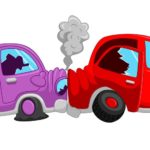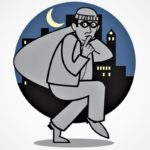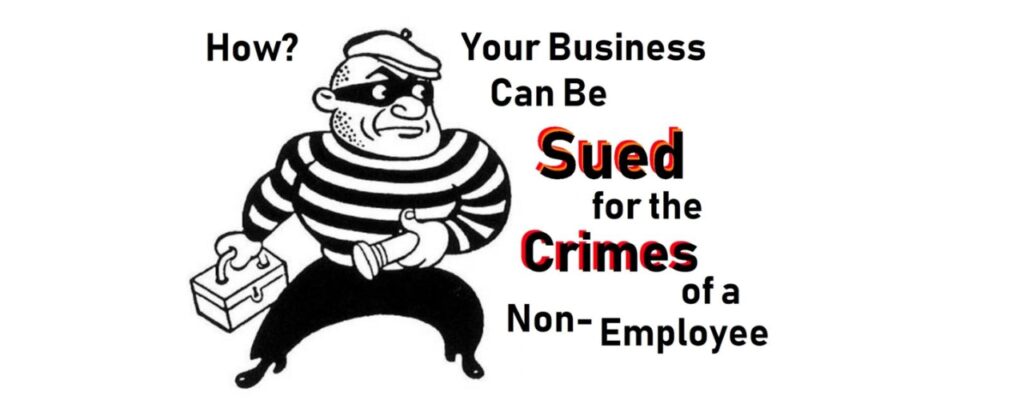Pedestrian Hit by a Car in a Parking Lot

It is Saturday night. Robert owns a local coffee shop. This coffee shop is a building and a parking lot next to a crowded street. Young people like to congregate and socialize in its parking lot Saturday nights.
Bob’s Coffee Shop tolerates the people hanging out in its parking lot. Perhaps Bob remembers when he was young. Perhaps it increases his customer base. Perhaps Bob is simply busy with the running of the business and tolerates their presence, having fun on his coffee shop property.
The kids like to stand around and socialize. Others “hot rod” through the parking lot. They speed; they play chicken; some even drive drunk.
One Saturday night is particularly busy. There are a number of people hanging out in the parking lot. Others are showing off driving through, speeding, drinking, and driving. A young girl gets hit by one of the drivers. Can the victim hire an auto accident lawyer to sue Bob for failing to kick the drivers or pedestrians out of his parking lot?
The General Rule; the Owner Cannot be Sued.
The general legal rule is that business owners do not have a duty to protect their invitees from the criminal acts of third parties. See Posecai v. Wal-Mart Stores, 752 So.2d 762 (La. 1999); Sturbridge Partners, Ltd., et al. v. Walker, 267 Ga. 785, (1997).
Owners do not generally have a duty protect their people on their property from the negligence of others who do not work for them or represent them. Burnett v. Stagner Hotel Court, Inc., 821 F.Supp. 678, 682 (N.D. Ga. 1993). There is an exception.
The “special facts and circumstances” exception that creates business liability.

A business owner can be liable to a victim on his property even when the perpetrator had nothing to do with the business owner.
The special facts and circumstances exception applies with the following test:
- Is the perpetrator a third party? (Not the business itself or one of its agents)
- Is the perpetrator known to be violent? Did the person behave in a way that indicated danger was on the premises?
- Did the business owner have sufficient time to prevent an injury?
Ali Aziz v. Jack in the Box, 477 S.W.3d 98 (Mo. App. 2015).
Foreseeability is the Key
Our Supreme Court has spoken about this issue. The “touchstone for the creation of a duty is foreseeability.” Madden v. C & K Barbeque Carry-out, Inc., 758 S.W.2d 59, 62 (Mo. 1988). It’s all about the facts of the situation. Is there a foreseeable likelihood that failing to act will cause harm? Then you likely have a duty.
Can the business owner anticipate that acting in the way that he does will cause injury? Then there is duty. In Aziz, there was a fight in a parking lot and Jack in the Box was held $20.5 million dollars liable for the resulting harm.
In another case, an innocent victim was raped in a gas station parking lot by an unknown person. The court and the jury found the circumstances created a dangerous situation for the victim that the gas station owners could have fixed. Instead, the owners did nothing and she suffered great harm. Richardson v. QuikTrip Corp., 81 S.W.3d 54 (Mo.App. W.D. 2002).
Do We Actually Need To Know About The Threat?
Actual notice of a specific threat is not a requirement to be held liable for accident injuries on property. There is only the requirement that someone (a third party; not connected with the business) acts in a way that indicates a danger on the business owner’s property and that also there is sufficient time to prevent that injury.
Does The Danger Always Have To Be To The Actual Victim?
The law refers to these people as “invitees.” These are people who come to the property because the business invites the public generally. They may also come with a specific expectation of some benefit by being on the business owner’s property. We are talking more about customers and less about burglars.
The anticipated risk of injury does not have to be to the actual victim that winds up getting hurt. The victim merely needs to be in the class of people or the type-of-person who is put at risk.
Referring to our example of Bob’s Coffee Shop, the crowd generally was at risk for being hit by an automobile and creating a pedestrian auto accident. It is not necessary for the victim to have been there a long time or acted in a particular way. This is more about a duty of care to prevent an injury by a known danger or a danger that could have been revealed by an adequate inspection. The victim does not need to actually enter the business. They do not actually have to complete a transaction. Aziz, 477 S.W.3d 98.
Conclusion
Pedestrian auto accidents are some of the most harmful events caused by cars. The victims do not have the benefit of the protection of seat-belts and roll cages or airbags. Business owners need to be mindful of all types of injury on their premises and not merely turn a blind eye because they are not the direct perpetrator. If they do, they may find themselves with a personal injury lawsuit and claim against them.



